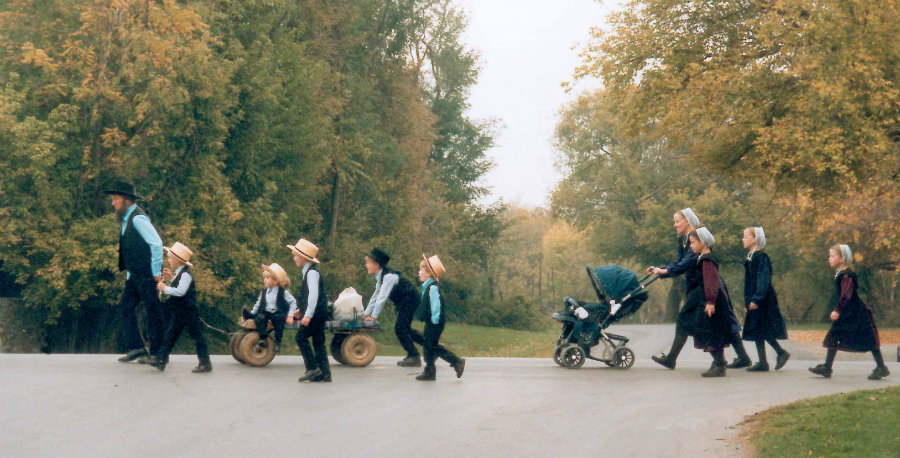Researchers discovered that microbiome composition in farmers’ dust homes might prevent allergies in children. It was unveiled on Wednesday that the Amish population is largely protected from asthma because farms animals’ microbes bolster their immune systems.
Despite sharing similar genetic backgrounds, including Central European immigrants heritage and following a traditional Germanic farming diet, The Amish and the Hutterites have certain differences regarding their farming methods.

On one hand, the Amish live on single-family dairy farms, they are known for their simple living and dislike of modern technology. They do not use electricity and use horses to pull their plows and for transportation and their barns are close to their homes where their children usually play. On the other hand, the Hutterites use modern, industrialized farm machinery to work their larger, communal farms.
Another huge difference among both farming populations is asthma rates. So, scientists decided to conduct a study to assess the causes explaining the huge breach on both groups.
Barnyard microbes protect Amish kids from asthma
Encouraged by a peculiar tendency the Amish of Indiana and the Hutterites of North Dakota, a group of researchers began to investigate asthma factors in children from the two separate farming groups. Asthma is not common among the Amish (only 2 to 4 percent of the population) as opposed to Hutterites asthma rates (with 15 to 20 percent). Hence, keeping in mind that both populations are agricultural, researchers wanted to evaluate what factor was protecting more one group from asthma.
In the small study, researchers looked at 30 Amish children and 30 Hutterite children-both groups aged seven to 14- to determine what sort of immune cells were in their blood. Blood tests revealed that showed the Amish kids had more blood cells crucial to fighting infections, known as neutrophils.
By using a mouse model of experimental allergic asthma, researchers realized lab mice exposed to the Amish house dust were protected against asthma due to their response to allergens. In turn, lab mice exposed to the Hutterite house dust showed no protection against allergens.
The results showed up, therefore, that the difference of asthma rates among the Amish and the Hutterites came down to the kind of dust inside their homes. Dust in Amish homes was apparently much richer in microbial products compared to the dust in the Hutterite residences.
Nevertheless, researchers remarked it is not a matter of cleanliness but microbial products containing in the homes’ dust.
“Neither the Amish nor the Hutterites have dirty homes. Both are tidy. The Amish barns, however, are much closer to their homes. Their children run in and out of them, often barefoot, all day long. There’s no obvious dirt in the Amish homes, no lapse of cleanliness. It’s just in the air, and in the dust,” explained study’s co-author Carole Ober, professor and chairperson of human genetics at the University of Chicago.
The dust in Amish homes engages the kids’ innate immune system to protect them against asthma. Further on, it was discovered that the Amish also had fewer blood cells promoting eosinophils, an allergic inflammation.
Researchers were amazed about the findings.
“We never thought we would see a difference. We saw whopping differences with very, very different cell types and cell numbers,” said Ober.
Environments are too clean
According to Sherry Farzan, a doctor in the department of medicine and pediatrics, allergy and immunology at Northwell Health in New York, the findings come to restate an idea that has been around for several years. Previous studies have proved that a growing number of children develop asthma because their daily environments are simply too clean, and a lack of early microbial exposure increases the risk of allergy.
Over the years, the scientific community has conducted numerous efforts to study the causes of such chronic disease and it was revealed that children growing up in an extremely clean environment are more likely to develop asthma. This has been called as “the hygiene hypotheses” and every single study carried out about the issue has restated the same conclusion.
It seems like the more children are exposed to microbes, the more they can develop body’s defense mechanisms to protect themselves against asthma. The hygiene hypothesis refers to environments containing bacteria stimulate children’s immune system in the first few years of life, that way the children’s immune system is more likely to reject any damaging external agent, including asthma carriers.
As per Farzan, exposure to a rich microbiome early in life is protective of allergy and asthma, and the reason lays on the anti-inflammatory modulatory activity of such exposure.
Several studies have demonstrated that infants who grew up in farms presented fewer asthma rates compared with those who grew up in different environments. However, other factors were playing a role, besides the environmental ones, in the development of the disease. It was not clear, thus, what was making a difference in children’s asthma rates.
This time, researchers hit the spot by assessing the microbiome composition of indoor dust samples at the Amish and Hutterites environments.
The findings were published on Wednesday in the August 4 edition of the New England Journal of Medicine.
Source: The New England Journal of Medicine
